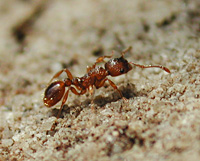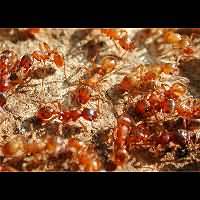[All pictures of garden wildlife on this page are thumbnails. Click on any thumbnail for a large format to be displayed.]

Common Red Ant or European Fire Ant (Myrmica rubra)
| Taxonomy | ||||||
|---|---|---|---|---|---|---|
| Kingdom: | Phylum: | Class: | Order: | Family: | Genus: | Species: |
| Animalia | Arthropoda | Insecta | Hymenoptera | Formicidae | Myrmica | M. rubra |
In the genus Myrmica we find rather primitive ants. They are all still in the possession of a fully functional stinger. And most of them can deliver a rather painful sting, even though the sting is not as painful as a wasp's. However the animals do not produce formic accid as the Formica species do. On the European continent there are two very similar species. Most common is Myrmica rubra. The animal has two spines at the end of the front part of the body. These spines however are shorter than those of its twin Myrmica ruginodis. Other characteristics of Myrmica rubra are the reddish colour and the slightly darker head. But colour variations are common. Some animals maybe yellowish red, other brownish red. Those variations may apply to a colony as a whole, but individual variations are common as well. Workers are some 0.4 to 0.5 mm long. Queens and males may be slightly larger. This ant does not make ant hills. Each colony may contain several queens. One colony may consist of numerous nests. Those nests are rather small and very hard to find. Unless you sit on top of it. You are in for an unpleasant treat, for Myrmica rubra is very aggressive. And once under attack by a lot of ants, you seek shelter elsewhere quickly. Some humans are allergic to the stings, but that is extremely rare.
Myrmica rubra is an agile hunter. Big prey will be attacked by several ants at the same time. It also actively hunts spring tails. However dead animals will also be transported to the nest. And this species loves milking aphids as well. It is rarely seen on flowers eating nectar, though. Nuptial flights take place late in the year: in august or september. Like in all ants species the ones taking off are males and young queens. This species has been introduced in Northern America wehere it is now considered an unwanted invasive species. Oddly enough it doesn't fly in Northern America.
The nests are made under logs, under stones, between the roots of trees etc. A very common species all over Europe, including Britain. Also found in ruderal areas, but not as often as Lasius niger.

© Copyright 1998-2024 gardensafari.net (Hania Berdys)

 English / engels
English / engels  Dutch / nederlands
Dutch / nederlands


